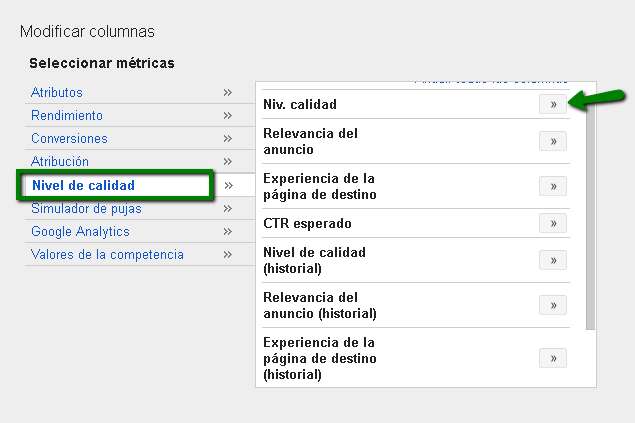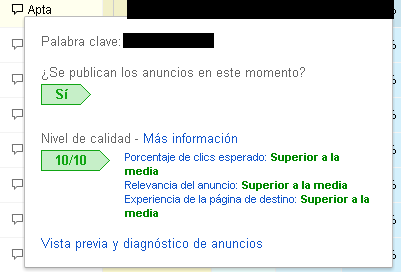Written by Maite Beltrán
Index
What is the AdWords Quality Score?
When we start using Google Ads, something to keep in mind is the quality score (QS). We should use it as an account diagnostic tool, not as a KPI. In this article I will try to explain in a simple way why it is important to be attentive to it and try to have the highest possible quality score. We will also see what factors will help us to keep it high.
The quality score of Google Ads is shown on a “basic” scale from 1 to 10, where 1 is the lowest or poorest level of quality and 10 is the highest quality that can be obtained. So far, so good. However, let’s look at Google’s definition: “Quality Score is an estimate of the quality of your ads, keywords and landing pages. Higher quality ads can contribute to lower prices and better ad position.”
What does the value of this quality score depend on in our Google Ads campaign?
There he already let us drop a few things, such as that it is not something that is decided “by hand”, but that come into play a number of variables on the basis of which Google gives you a specific score. In addition, this score is going to affect your ad position and the impressions you receive and also the average cost per click you pay. So, as I mentioned above, the higher our quality score, the better Google values us and the better results we will obtain.
In principle Google tells us that the quality score depends on your ads (relevance and expected number of clicks), the keywords (how relevant they are based on the ads and your account) and the landing page, which should give relevant information to the user and be related to your keywords and ads. Easy, huh?!
The fact is that the quality score is affected by many more variables, since there are factors that alter it in real time and this makes it a little more difficult to understand. In the end, it’s like everything Google does, a secret formula that they will never fully teach you but we have to try to follow the instructions to the letter if we want to be good advertisers (in Google’s eyes) and get more out.
Factors influencing the Google Ads Quality Score
If we dig and read, we will see that the quality score goes far beyond the conjunction of some aspects. Today, factors that affect or matter in determining the quality score are:
- Click-through-rate (CTR)
- The user’s device: whether users use a computer or mobile device and whether our campaigns and website are adapted to them.
- That the keywords appear in the title of the ad.
- That the keywords appear in the body of the ad.
- Having “negative” words. That is to say, filter out those words that do not contribute anything to our campaigns for our objective and add them as negative in order not to appear for those search terms.
- Make the landing pages relevant.
- Account extensions (featured text, site excerpt and site links).
Learn how to analyze the quality score of your keywords
Knowing this, how can we analyze the quality score of our keywords?
- Score of 1 – 2. Very bad. At this quality score Google barely shows your ads and you should check what you are doing wrong and correct it as soon as possible.
- From 3 – 4. Mala. The ads do not show very often and when they do you will be paying more per click than the normal average cost. You should review everything and correct what is not right to try to improve.
- From 5 – 8. Well. You are on the right track but there is still room for improvement. Here you have to go into more detail to see what may be going wrong with your strategy. Review each ad group, check that the words you are using match the ads and the landing pages. Also analyze the CTR of each word, the bids and even if you have too many keywords in an ad group (it is recommended not to exceed 20 words in each group).
- And of 9 – 10. Great! Here you are already maxing out your account and that’s a good thing. However, even with a 9 there is room for improvement. For Google Ads there is always room for improvement. You can think of it this way: between each number there are “decimals”, i.e. between 9 and 10 there can be 9.1, 9.2, 9.3, etc. and you have to go through each of them to get to 10 and getting to each of them first is not easy either, so you will have to work and be patient.
The quality score is thus, in short, an indicator that tells us when we are doing something wrong and goes through several stages. When it is red it indicates that something is wrong, then it turns amber as we improve and finally green. In no case should we take it as a metric on the basis of which to make decisions, but it should alert us to take it into account in the strategy we follow.
Why is it important?
And well, why is it important and why can’t we pass on it? Well, because if we want to be among the first (and we all do), the quality score is paramount in this matter. Google explains it quite well and although they could have been more specific, it is clear what we have been talking about, isn’t it?
Another aspect that makes us see that the quality score is very important is that Google, since a few weeks ago, has released new columns for the quality score. Where before we had to extract it and it was found as an attribute, now it has its own set of columns with its indicators. This column must be searched and extracted, because if you go to the keywords tab in your account, you will see that it is not there by default.
How can we improve it?
Once you have done this you will be able to see the quality of your keywords. In addition, Google is not so “bad” and also helps you to know what you are doing right or wrong by means of information balloons that appear next to each keyword. This will make it easier for you to detect where you need to put your best efforts:
Additional references on the quality score
- Defining Google Ads Quality Score
- Patents related to Google’s Quality Score
- The level of quality in Bing Ads campaigns
- Frequently asked questions about the quality score in Bing Ads
Now it’s time to roll up your sleeves and get to work!
And your quality score, how is it going?



